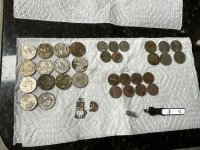What is the minimum oz per ton for a claim to be worth mining?
You are using an out of date browser. It may not display this or other websites correctly.
You should upgrade or use an alternative browser.
You should upgrade or use an alternative browser.
Ore question
- Thread starter mu50stang
- Start date
arizau
Bronze Member
- May 2, 2014
- 2,485
- 3,870
- Detector(s) used
- Beach High Banker, Sweep Jig, Whippet Dry Washer, Lobo ST, 1/2 width 2 tray Gold Cube, numerous pans, rocker box, and home made fluid bed and stream sluices.
- Primary Interest:
- Prospecting
The main definition of ore is that it is not really considered to be "ore" unless it can be mined profitably.
Last edited:
There is no standard answer. Could be as low as 3 grams a yard to as high as a thousand ounces per ton.
The point of mining is to make a profit. Before you can figure out if a deposit might be profitable you need to determine the nature and extent of the deposit.
The nature of the deposit is about what type of material needs to be mined to obtain ore. Hard rock is generally more expensive and requires more investment. Placer can be less expensive to mine. If the ore needs extensive processing and a lot of water or power imported costs go up. If it's hard to get to and mine it changes the nature of the deposit. Transportation, labor, lodging, fuel, equipment, repairs and maintenance and throughput need to be calculated to best fit the deposit. Marketing, depreciation, permitting and taxes need to be factored in.
The extent of the deposit is just as important. Whether hardrock or placer you will need to drill and profile the deposit so you know where the pay grades are and how much mineral you can reasonably recover from the deposit.
That's the simple version. Do the math on the recoverable ore in place minus the cost to extract, refine and market it and you will discover what market price you will need to get for your finished product to break even. From there you need to see if there is enough headroom on the market price to provide you with a reasonable profit over the period of time it will take to mine, process and market the deposit.
If you are thinking of placer mining studying the Cost Estimation Handbook for Small Placer Mines would be a good starting point. It's only 100 pages but it's a good overview of what is required to check a placer deposit for potential profit by first discovering your cost basis.
Hope that helps!
Heavy Pans
The point of mining is to make a profit. Before you can figure out if a deposit might be profitable you need to determine the nature and extent of the deposit.
The nature of the deposit is about what type of material needs to be mined to obtain ore. Hard rock is generally more expensive and requires more investment. Placer can be less expensive to mine. If the ore needs extensive processing and a lot of water or power imported costs go up. If it's hard to get to and mine it changes the nature of the deposit. Transportation, labor, lodging, fuel, equipment, repairs and maintenance and throughput need to be calculated to best fit the deposit. Marketing, depreciation, permitting and taxes need to be factored in.
The extent of the deposit is just as important. Whether hardrock or placer you will need to drill and profile the deposit so you know where the pay grades are and how much mineral you can reasonably recover from the deposit.
That's the simple version. Do the math on the recoverable ore in place minus the cost to extract, refine and market it and you will discover what market price you will need to get for your finished product to break even. From there you need to see if there is enough headroom on the market price to provide you with a reasonable profit over the period of time it will take to mine, process and market the deposit.
If you are thinking of placer mining studying the Cost Estimation Handbook for Small Placer Mines would be a good starting point. It's only 100 pages but it's a good overview of what is required to check a placer deposit for potential profit by first discovering your cost basis.
Hope that helps!

Heavy Pans
Last edited:
5g/ton is the benchmark if you are referring to gold. That number does not hold if you are thinking of placer mining.
Although I have just recently learned if I open cast and extract 1g per ton by gravity and pull out 30 tons of reef per day with a combination of backhoe and blasting, I break even. What that then leaves me is approximately 1g per ton to be treated by cyanide which is pure profit.
Going down a shaft however being harder to mine your grades need to be higher than that. I don’t put much effort into a shaft with free gold running at less than 3g per ton unless the sand also runs high.
We all have our own sets of variables which work for us. The first thing a miner should ever do is find what grades work for the variables you have.
Top Member Reactions
-
 2311
2311 -
 1122
1122 -
 1042
1042 -
 898
898 -
 832
832 -
 770
770 -
 754
754 -
 738
738 -
 606
606 -
 508
508 -
 494
494 -
 476
476 -
 448
448 -
 420
420 -
O
398
-
 397
397 -
 397
397 -
 392
392 -
 383
383 -
 376
376
Users who are viewing this thread
Total: 2 (members: 0, guests: 2)






